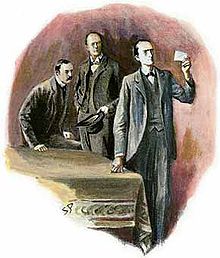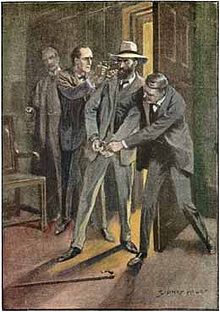- The Adventure of the Dancing Men
-
"The Adventure of the Dancing Men" by Arthur Conan Doyle Released 1903 Series The Return of Sherlock Holmes Client(s) Hilton Cubitt Set in 1898 Villain(s) Abe Slaney "The Adventure of the Dancing Men", one of the 56 Sherlock Holmes short stories written by British author Sir Arthur Conan Doyle, is one of 13 stories in the cycle collected as The Return of Sherlock Holmes. Doyle ranked "The Adventure of the Dancing Men" third in his list of his twelve favorite Holmes stories.
Contents
Synopsis
Mr. Hilton Cubitt of Ridling Thorpe Manor in Norfolk visits Sherlock Holmes and gives him a piece of paper with this mysterious sequence of stick figures.

The little dancing men are at the heart of a mystery which seems to be driving his young wife Elsie to distraction. He married her about a year ago, and until recently, everything was well. She is American, and before the wedding, she asked her husband-to-be to promise her never to ask about her past, as she had had some “very disagreeable associations” in her life, although she said that there was nothing that she was personally ashamed of. Mr. Cubitt swore the promise and, being an honourable English gentleman, insists on living by it, which is one of the things causing difficulty at Ridling Thorpe Manor.
The trouble began when Elsie received a letter from the United States, which evidently disturbed her, and she threw the letter on the fire. Then the dancing men appeared, sometimes on a piece of paper left on the sundial overnight, sometimes scrawled in chalk on a wall or door, even a windowsill. Each time, their appearance has an obvious, terrifying effect on Elsie, but she will not tell her husband what is going on. Holmes tells Cubitt that he wants to see every occurrence of the dancing men. They are to be copied down and brought or sent to him at 221B Baker Street. Cubitt duly does this, and it provides Holmes with an important clue. Holmes comes to realize that it is a substitution cipher. He cracks the code by frequency analysis. The last of the messages conveyed by the dancing men is a particularly alarming one.
Holmes rushes down to Ridling Thorpe Manor only to find Cubitt dead of a bullet to the heart and his wife gravely wounded in the head. Inspector Martin of the Norfolk Constabulary believes that it is a murder-suicide, or will be if Elsie dies. She is the prime suspect in her husband’s death. Holmes sees things differently. Why is there a bullet hole in the windowsill, making a total of three shots, while Cubitt and his wife were each only shot once? Why are only two chambers in Cubitt’s revolver empty? What is the large sum of money doing in the room? The discovery of a trampled flowerbed just outside the window, and the discovery of a shell casing therein confirm what Holmes has suspected — a third person was involved, and it is surely the one who has been sending the curious dancing-man messages.
Holmes knows certain things that Inspector Martin does not. He seemingly picks the name “Elrige’s” out of the air, and Cubitt’s stable boy recognizes it as a local farmer’s name. Holmes quickly writes a message — in dancing men characters — and sends the boy to Elrige’s Farm to deliver it to a lodger there, whose name he has also apparently picked out of the air. Of course, Holmes has learned both men's names by reading the dancing men code. While waiting for the result of this message, Holmes takes the opportunity to explain to Watson and Inspector Martin how he cracked the code of the dancing men, and the messages are revealed. The last one, which caused Holmes and Watson to rush to Norfolk, read “ELSIE PREPARE TO MEET THY GOD”.
The lodger, Mr. Abe Slaney, another American, unaware that Elsie is at death’s door and quite unable to communicate, duly arrives at Ridling Thorpe Manor a short while later, much to everyone’s astonishment, except Holmes’s. He has sent for Slaney using the dancing men, knowing that Slaney will believe that the message is from Elsie. He is seized as he comes through the door. He tells the whole story. He is a former lover from Chicago and has come to England to woo Elsie back. She originally fled his clutches because he was a dangerous criminal, as Holmes has found out through telegraphic inquiries to the US. When an encounter at the window where the killing happened turned violent with Hilton Cubitt's appearance in the room, Slaney pulled out his gun and shot back at Cubitt, who had already shot at him. Cubitt was killed and Slaney fled. Apparently, Elsie then shot herself. Slaney seems genuinely upset that Elsie has come to harm. The threatening nature of some of his dancing-man messages is explained by Slaney's losing his temper at Elsie's apparent unwillingness to leave her husband. The money found in the room was apparently to have been a bribe to make Slaney go away.
Slaney is arrested and later tried. He escapes the noose owing to mitigating circumstances. Elsie recovers from her serious injuries and spends her life helping the poor and administering her late husband’s estate.
References in other works
In Dorothy Sayers' The Nine Tailors, Lord Peter Wimsey struggles with a difficult code: "He had never seen a secret message that looked so innocent. Sherlock Holmes' Little Dancing Men were, by comparison, obviously secretive" (Second part, Ch. 8).
In Robert Harris' thriller Enigma the protagonist, a World War II British cryptanalyst and a Sherlock Holmes fan, is mentioned as solving the Little Dancing Men secret message while recuperating from a severe nervous breakdown; from his point of view, as a professional involved in solving the wartime codes of Nazi Germany, Doyle's coded message is "simple but elegant".
In the two-part episode of the anime Detective Conan titled "The Secret of the Sun, Moon and Stars", Professor Agasa and Shinichi Kudo (Conan Edogawa) suggest that the drawings of the sun, moon, and stars found on various objects in the home of Agasa's late uncle were a code much like the Dancing Men.
Adaptations
The 1943 film Sherlock Holmes and the Secret Weapon is loosely based on "The Adventure of the Dancing Men" but moved into a World War II setting.
"The Blind Banker" (the second episode of the 2010 BBC television series Sherlock featuring Benedict Cumberbatch as a 21st century Sherlock Holmes, and Martin Freeman as Dr. Watson) is loosely based on "The Adventure of the Dancing Men." Several elements of the story - such as Sherlock proving that a suicide was murder based on clues that indicate that someone else was in the room - and the use of ciphers to determine a series of messages - are borrowed from the original story.[1]
References
- ^ Steven Moffat tweeted "Cos people have asked: tonight's Sherlock ["The Blind Banker"] (written by Stephen Thompson, directed by Euros Lyn) is loosely based on The Dancing Men." http://twitter.com/steven_moffat/status/20070229167
There was also a British TV series starring the late Jeremy Brett as Sherlock Holmes. It was produced by Granada UK and developed for television by John Hawkesworth. In it a series of episodes called "The Adventures of Sherlock Holmes" of which one episode was entitled "The Dancing Men". It starred Jeremy Brett with David Burke as Dr. Watson. It was adapted by Anthony Skene. The entire series was shown here in the United States on PBS (Public Broadcasting Service).
Wikisource links
 Works related to The Adventure of the Dancing Men at Wikisource
Works related to The Adventure of the Dancing Men at Wikisource"The Adventure of the Empty House" (the return of Holmes) · "The Adventure of the Norwood Builder" · "The Adventure of the Dancing Men" · "The Adventure of the Solitary Cyclist" · "The Adventure of the Priory School" · "The Adventure of Black Peter" · "The Adventure of Charles Augustus Milverton" · "The Adventure of the Six Napoleons" · "The Adventure of the Three Students" · "The Adventure of the Golden Pince-Nez" · "The Adventure of the Missing Three-Quarter" · "The Adventure of the Abbey Grange" · "The Adventure of the Second Stain"
Categories:- Sherlock Holmes short stories by Arthur Conan Doyle
- 1903 short stories
- Encodings
- Norfolk in fiction
Wikimedia Foundation. 2010.


